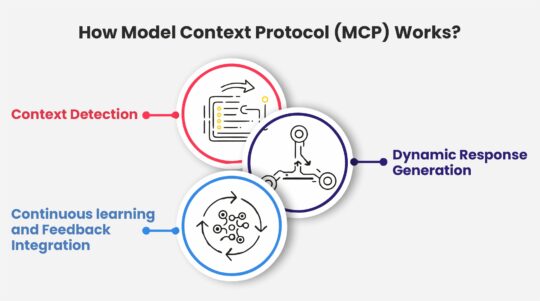Artificial intelligence (AI) has come a long way from static, predetermined responses to more dynamic and context-sensitive interactions. Among the major key advancements in this area is Model Context Protocol (MCP), a framework that allows AI systems to understand and adapt to or respond to different scenarios.
Unlike traditional AI models that follow static rules, MCP allows AI to change its behavior depending on the context of the interaction. This results in more efficient, accurate, and user-friendly AI.
Why Context is Important in AI?
AI systems are used in different environments by users like customer support, healthcare, finance, and so on. A one-size-fits-all approach is not applicable because every situation requires a unique tone, level of information, and style of communication.
For Instance:
-
- A medical AI must explain diagnoses differently to doctors (in a technical manner) and patients (in a simplified manner).
- A financial advisor AI should adjust its responses based on whether the user is a beginner or an expert.
- A customer service chatbot must recognize urgency and respond accordingly.
Without a model context protocol, AI would struggle to provide relevant and precise answers, leading to poor user experiences.
How Does the Model Context Protocol Work?
1. Context Detection
The first step is for AI to analyze the situation. It evaluates factors such as:
-
- User intent (is the query informational, transactional, or problem-solving?)
- User expertise level (Is the user a professional or a novice?)
- Industry-specific requirements (Legal, medical, or technical contexts require different responses.)
2. Dynamic Response Generation
Once the AI understands the context, it adjusts its output. For example:
-
- In legal consultations, AI provides precise, citation-backed responses.
- In educational tutoring, AI simplifies explanations for better comprehension.
- In e-commerce, AI uses product recommendations based on browsing history.
3. Continuous learning and Feedback Integration
AI improves by learning from user interactions. If a response is frequently corrected or refined, the system adapts to deliver better results in the future. This ensures that the model context protocol keeps evolving for higher accuracy.
Real-world Applications of Model Context Protocol
1. Healthcare: IBM Watson
IBM Watson uses a model context protocol to assist doctors by analyzing medical records, research papers, and patient history. It provides treatment suggestions in a structured, evidence-based manner while simplifying explanations for patients.
2. Customer Support: Zendesk AI
Zendesk’s AI-powered chatbots use MCP to detect customer sentiment and urgency. If a user is frustrated, the bot prioritizes quick resolutions. If the query is informational, it provides detailed guidance.
3. Finance: AI-powered Investment Advisor
Robo-advisors like Betterment and Wealthfront use model context protocol to customize financial advice based on risk tolerance, investment goals, and market trends.
The Importance of Model Context Protocol in AI Development
Implementing MCP offers several advantages:
-
- Enhanced User Experience: AI responses become personalized and more relevant.
- Higher Efficiency: Reduces misinterpretations and repetitive queries.
- Scalability: Works across industries, from healthcare to finance.
- Continuous Improvement: Learns from interactions to refine future responses.
Without this protocol, AI interactions would remain rigid and inefficient, limiting their real-world applicability.
Future Developments in Model Context Protocol
As AI technology progresses, the model context protocol is expected to advance in the following ways:
-
- Emotion Recognition: AI will detect user emotions (frustration, satisfaction, and others) and adjust responses accordingly.
- Cross-Lingual Adaptability: Easy transition between languages without losing contextual accuracy.
- Industry-Specific Customization: Deeper specialization in fields like law, medicine, and engineering.
These improvements will make AI interactions very similar to human interactions.
Final Words
Model context protocol is an important breakthrough in AI technology that allows systems to understand and respond to various situations sensibly. Through the addition of context awareness, dynamic response generation, and ongoing learning, MCP keeps AI efficient, accurate, and easy to use.
With further developments in this technology, we can expect AI systems to become increasingly intuitive, closing the gap between human and machine interactions.
To learn more, visit WisdomPlexus!
FAQ
Q: What is the model context protocol?
Ans: Model context protocol (MCP) is an architecture that makes AI models understand and learn various contexts so that they can respond more relevantly and effectively, as humans do.
Q: What is MCP used for?
Ans: MCP enhances AI interactions by making systems capable of modifying their tone, depth, and style according to context, making them more applicable in customer service, healthcare, and other domains.
Q: What is MCP in LLM?
Ans: In large language models (LLMs), MCP assists in making responses more personalized by evaluating user intent, level of expertise, and context needs for more natural and accurate conversations.
Recommended For You:
Role of two phase commit protocol in Database Management





